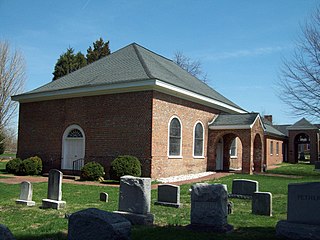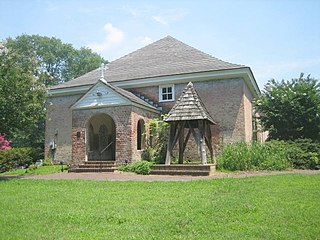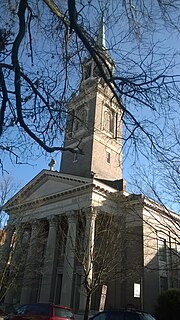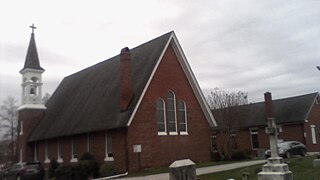
Thomas John Claggett was the first bishop of the newly formed American Episcopal Church, U.S.A. to be consecrated on American soil and the first bishop of the recently established (1780) Episcopal Diocese of Maryland.
Collington is a now defunct settlement in Prince George's County, Maryland, United States, dating from colonial times. Collington has been subsumed by the city of Bowie.

St. Barnabas Church, also known as St. Barnabas' Episcopal Church, Leeland, was built in Leeland, Maryland and was established in 1704 as the parish church of Queen Anne Parish which had been established that same year. Because of its location in one of the richest tobacco-producing regions in Colonial Maryland, the small church has been a cultural hub for southern Maryland from early colonial times, through the American Revolution, Civil War, and Reconstruction. The church holds some highly significant art and was the scene of a fiery anti-revolutionary showdown that was close to erupting in violence.

Mareen Duvall (1625–1694) was a French Huguenot and an early American settler.
Jacob Henderson was an Irish clergyman and philologist who emigrated to the colonial Provinces of Pennsylvania, then Maryland, where he became a prominent land owner and church leader.

St. James' Parish is a historic church located on Solomons Island Road in the hamlet of Tracys Landing, Anne Arundel County, Maryland, United States.

St. Paul's Episcopal Church is a parish of the Episcopal Church near Point of Rocks, Frederick County, Maryland, in the Episcopal Diocese of Maryland. It is noted for its historic parish church, a small late Federal style brick structure built in 1842.

"St. John's Church", "St. John's Episcopal Church", or "St. John's Episcopal Church, Broad Creek", is a historic Episcopal church located at 9801 Livingston Road in Fort Washington, Prince George's County, Maryland. It is a rectangular Flemish bond brick structure with a bell hipped roof. The interior features a barrel vaulted ceiling with an intricate support system.

St. Anne's Episcopal Church is a historic Episcopal church located in Church Circle, Annapolis. The first church in Annapolis, it was founded in 1692 to serve as the parish church for the newly created Middle Neck Parish, one of the original 30 Anglican parishes in the Province of Maryland. It remains in use by the Parish of St. Anne, part of the Episcopal Diocese of Maryland.

The Christ Church Guilford, historically known as the "Old Brick Church," is an historic Episcopal church located about one mile from Guilford, now part of Columbia, in Howard County, Maryland. The small Georgian church was completed in 1809. It was constructed of handmade brick laid in English garden wall brick bond with unmarked joints.

Old Trinity Church, also known as Trinity Church, Oxford, is a historic Episcopal church established in 1696. in Oxford Township, Pennsylvania, which is now part of Philadelphia.

St. Mary Anne's Episcopal Church is an historic Episcopal church building located at 315 South Main Street in North East, Cecil County, Maryland. Built in 1742 of red brick in a rectangular shape to replace an earlier wooden church building on the site, it is the second parish church building for North Elk Parish, later known as St. Mary Anne's Parish, which had been established in 1706 by the General Assembly of the Province of Maryland. Originally dedicated to St. Mary, the parish added Anne to its name in thanks for a bequest it received from the estate of Anne, Queen of Great Britain, who died in 1714. Its bell tower was added in 1904.

Walter Dulany Addison was an Episcopal clergyman who served as Chaplain of the United States Senate (1810–1811).

Stephen Higginson Tyng was a leading clergyman of the evangelical party of the Episcopal Church. He recognized that a new urban ministry was needed in parts of New York City with growing numbers of immigrants. He instituted social service programs as well as altering church interiors to make people feel more welcome.

St. John's Church, or St. John's Episcopal Church, founded in 1786, is an historic Episcopal church located at 101 South Prospect Street in the South Prospect Street Historic District of Hagerstown, Maryland. It is the seat of Saint John's Parish, Diocese of Maryland, which covers most of Washington County, Maryland.

The Church of the Epiphany was an Episcopal congregation in Philadelphia, Pennsylvania. Founded in 1834, it merged with St. Luke's Church in 1898 to form The Church of St. Luke and the Epiphany. Its 1834 Greek Revival building, designed by architect Thomas Ustick Walter and located at 1501-15 Chestnut Street, was demolished in 1902.
Petersville is an unincorporated community in Frederick County, Maryland, United States. Petersville is located at the junction of Maryland routes 79 and 180, 1.3 miles (2.1 km) northeast of Rosemont.

The Cathedral Church of the Nativity is an Episcopal cathedral in Bethlehem, Pennsylvania, United States. It is the seat of the Diocese of Bethlehem. In 1988 it was listed as a contributing property in the Fountain Hill Historic District on the National Register of Historic Places.

St. James's Episcopal Church is the third oldest Episcopal congregation in Richmond, Virginia. Only the older St. John's Episcopal Church on Church Hill also remains an active congregation.

St. John's Episcopal Church, Zion Parish in Beltsville, Maryland is a historic place of worship whose congregation dates back more than two centuries.

















